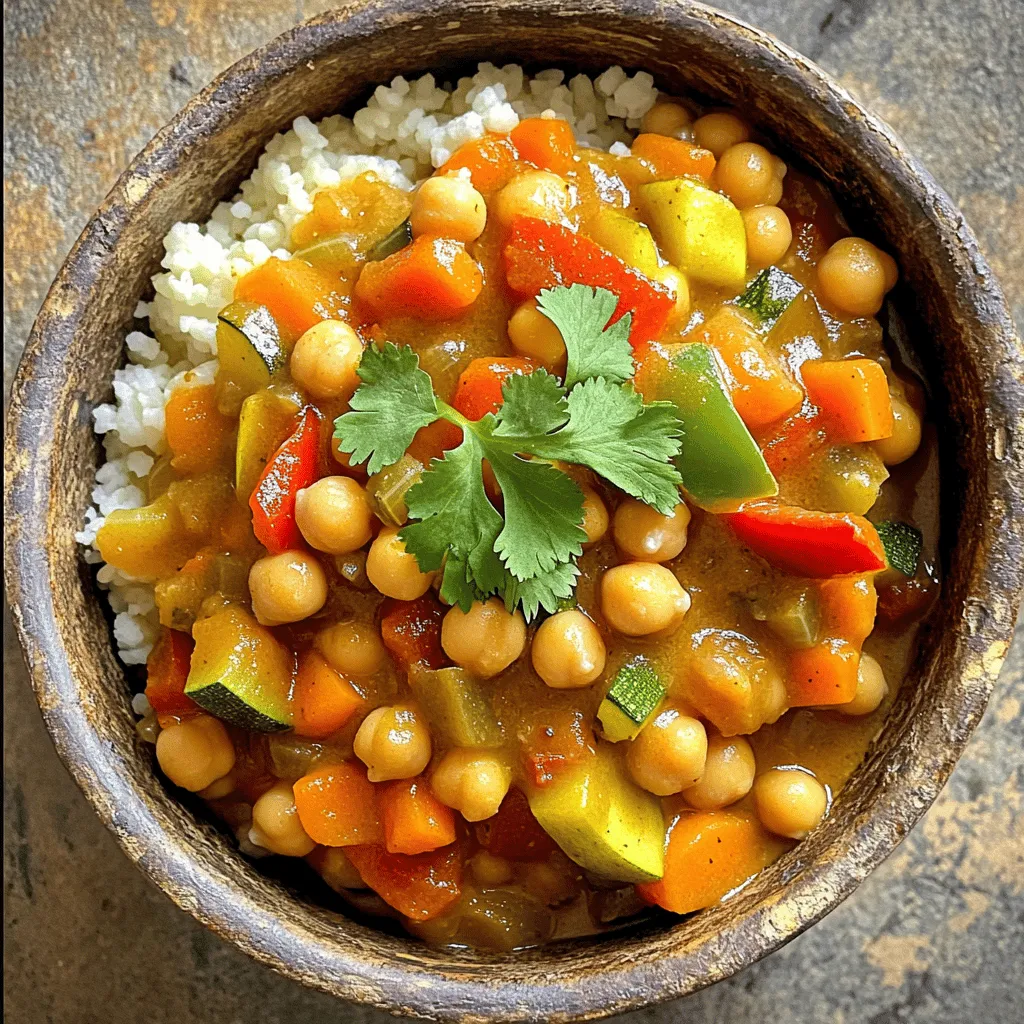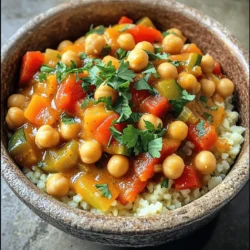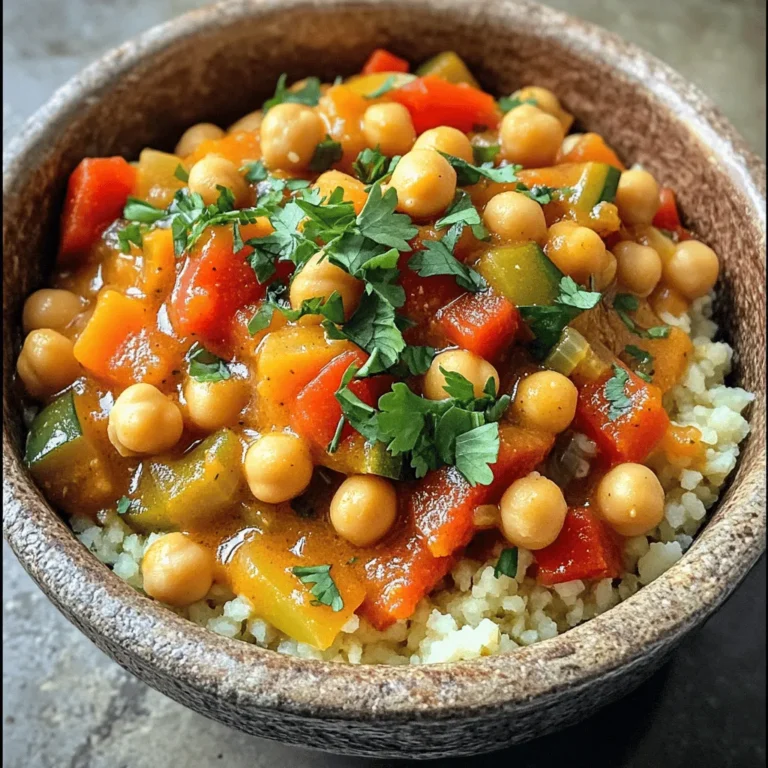Are you ready to explore a world of flavor? This Slow Cooker Moroccan Chickpea Stew is a delightful mix of spices, veggies, and hearty chickpeas. Perfect for busy days, you can prep it and let the slow cooker do the work. In this post, I will guide you through the ingredients, steps, and tips to create this tasty dish. Let’s dive in and spice up your meal plan!
Ingredients
Main Ingredients
– 2 cans chickpeas
– 1 large onion
– 3 cloves garlic
Vegetables
– Carrots
– Red bell pepper
– Zucchini
Seasonings and Broth
– Ground spices
– Vegetable broth
– Raisins or dried apricots
The heart of this stew lies in the ingredients. For the main part, you will need two cans of chickpeas. These legumes offer a creamy texture and are high in protein. Use one large onion, finely diced, to bring a sweet base to the dish. Three cloves of garlic, minced, add a punch of flavor.
Next, we have the veggies. Slice two medium carrots into rounds for sweetness and color. Add a diced red bell pepper for a bit of crunch. A coarsely chopped zucchini rounds out the mix for a fresh taste.
Now, let’s talk seasonings. You’ll want to gather your ground spices. These include cumin, coriander, cinnamon, and paprika. A pinch of cayenne adds heat. Use low-sodium vegetable broth to keep it healthy. Finally, toss in a quarter cup of raisins or chopped dried apricots for a touch of natural sweetness.
With these ingredients, you set the stage for a flavorful and satisfying meal. Each element plays a key role, making every bite a delight.
Step-by-Step Instructions
Preparing the Base
Start by heating olive oil in a large skillet over medium heat. Add the diced onion and cook it until it turns soft and clear, about five minutes. Next, add minced garlic, sliced carrots, and diced bell pepper. Cook for another three to four minutes. This step makes the base flavorful and aromatic.
Combining Ingredients
Once the vegetables are ready, transfer them to the slow cooker. Add two cans of drained and rinsed chickpeas, chopped zucchini, and one can of undrained diced tomatoes. Pour in one cup of vegetable broth and add a quarter cup of chopped raisins or dried apricots. This mix will give the stew a sweet touch.
Cooking Process
Cover the slow cooker lid and set it to cook on low for six to eight hours. If you’re short on time, set it to high for three to four hours. After cooking, taste the stew and adjust the seasoning. If the stew is too thick, stir in some more broth until it reaches your desired consistency.
Tips & Tricks
Enhancing Flavor
To make your stew even better, try adjusting the spices. If you like it spicy, add more cayenne. For warmth, increase the cinnamon and cumin. A dash of lemon juice can balance the flavors nicely. This adds brightness and cuts through the richness. Consider using a splash of vinegar too. It works wonders for depth.
Presentation Tips
When serving, dish the stew in deep bowls. This adds an inviting look. You can serve it over fluffy couscous or quinoa. For extra flair, add a lemon wedge on the side. It brightens the plate and flavor. Garnish with fresh cilantro or parsley. A sprinkle of crushed nuts, like almonds, adds crunch and texture.
Cooking Efficiency
Prep your ingredients ahead of time for a smooth cooking experience. Chop the veggies and store them in the fridge. You can also use frozen vegetables to save time. They work well and can cut prep time in half. Just remember to adjust cooking times slightly. This way, you still enjoy a hearty and flavorful stew.

Variations
Different Protein Options
You can change the protein in this stew to suit your taste. If you want meat, try chicken or lamb. Just add it to the slow cooker with the chickpeas. For a vegan option, use tofu or tempeh. These options add great flavor and texture.
Spice Variations
The spices really make this stew shine. If you like heat, add more cayenne pepper. Start with a small pinch and taste as you go. You can also try other spices like turmeric or ginger. These spices add warmth and depth to the dish.
Alternative Serving Suggestions
Serving this stew over grains can enhance your meal. Couscous and quinoa pair well with the stew’s flavors. You can also try brown rice or farro for a hearty option. Adding a side salad or crusty bread can round out the meal nicely.
Storage Info
Refrigeration
Store your leftover Moroccan chickpea stew in an airtight container. Make sure it cools down first. This stew will stay fresh for up to five days in the fridge. If you want to enjoy it later, consider freezing it instead.
Freezing
To freeze the stew, pour it into freezer-safe bags or containers. Leave some space for expansion. Label the bags with the date. You can freeze it for up to three months. When you are ready to eat, move it to the fridge for a night to thaw.
Reheating Tips
When it is time to reheat, use a pot on the stove. This keeps the stew warm and tasty. Stir it often to make sure it heats evenly. You can also use a microwave. Heat it in short bursts, stirring in between. Add a splash of water or broth if it seems too thick. This will help keep the flavors and texture just right.
FAQs
How long does it take to cook Slow Cooker Moroccan Chickpea Stew?
It takes about 6-8 hours on low or 3-4 hours on high. The slow cooker does its magic by slowly blending flavors. Cooking on low gives a rich, deep taste. High heat cooks faster but may not infuse flavors as well.
Can I make it ahead of time?
Yes, you can make this stew ahead of time. Cook it completely, then cool and store it in the fridge. It stays fresh for about 3-4 days. You can also freeze it for longer storage. Thaw in the fridge before reheating.
Is it possible to make it spicy?
Absolutely! You can adjust the heat level easily. Add more cayenne pepper for extra spice. If you prefer less heat, reduce the cayenne. You can also add spicy peppers or hot sauce for a different flavor twist.
This blog showed you how to make a delicious Slow Cooker Moroccan Chickpea Stew. We covered key ingredients, like chickpeas, veggies, and spices. You learned step-by-step preparation and cooking methods. I shared tips to enhance flavor and presentation and explored variations to suit different tastes. Finally, you got storage tips to keep your stew fresh and tasty.
Now you’re ready to enjoy this hearty meal. Happy cooking!


